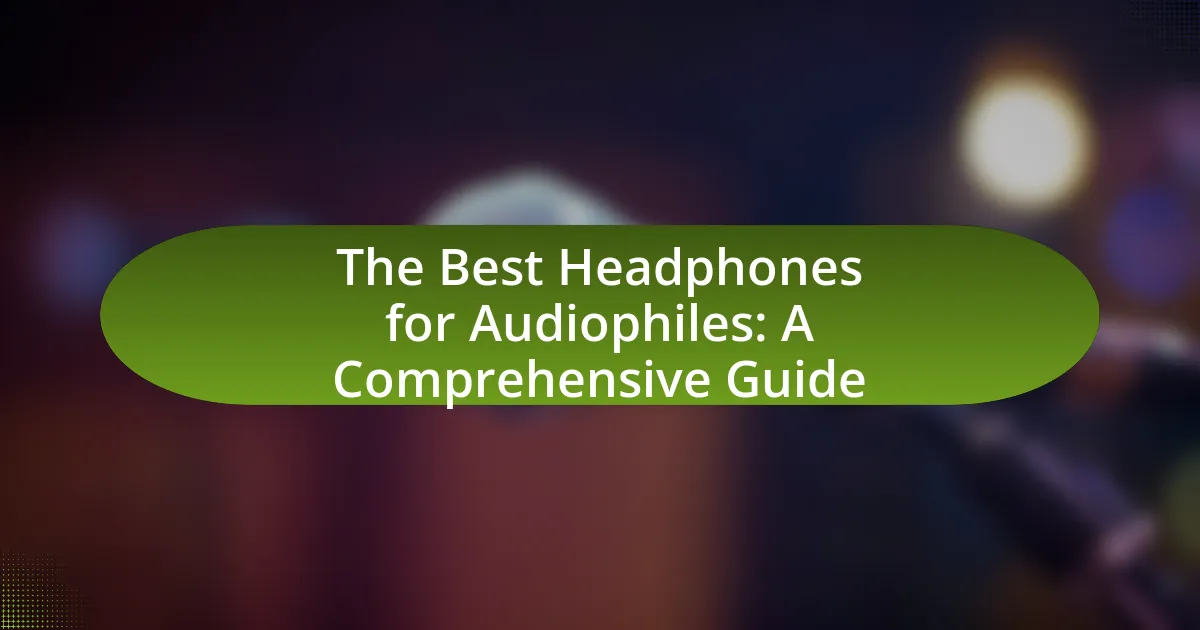The article focuses on the best headphones for audiophiles, detailing the characteristics that define high-fidelity sound reproduction, such as wide frequency response, low distortion, and high dynamic range. It compares audiophile headphones to regular models, emphasizing the importance of specifications like impedance, sensitivity, and driver types in sound performance. Key features of high-end headphones, including comfort and material quality, are discussed alongside the advantages of different headphone types, such as open-back and closed-back designs. The article also highlights popular brands, testing methods, and best practices for maintaining audiophile headphones, providing a comprehensive guide for discerning listeners.

What Makes Headphones Ideal for Audiophiles?
Headphones ideal for audiophiles are characterized by their high fidelity sound reproduction, which ensures accurate and detailed audio playback. These headphones typically feature wide frequency response, low distortion, and high dynamic range, allowing listeners to experience music as intended by the artists. For instance, models like the Sennheiser HD800S and Audeze LCD-X are renowned for their exceptional soundstage and clarity, making them favorites among audiophiles. Additionally, the use of high-quality materials in construction, such as planar magnetic drivers or dynamic drivers with advanced technology, contributes to the overall sound quality and comfort, further enhancing the listening experience.
How do audiophile headphones differ from regular headphones?
Audiophile headphones differ from regular headphones primarily in their sound quality and design. Audiophile headphones are engineered to provide a more accurate and detailed audio reproduction, often featuring higher-quality drivers, better materials, and advanced technologies such as open-back designs that enhance soundstage and clarity. For instance, many audiophile models utilize planar magnetic or electrostatic drivers, which can deliver superior sound fidelity compared to the dynamic drivers commonly found in regular headphones. This distinction is supported by reviews and comparisons in audio publications, which consistently highlight the enhanced listening experience provided by audiophile headphones, making them preferred choices for serious music enthusiasts.
What specifications should audiophiles look for in headphones?
Audiophiles should look for specifications such as frequency response, impedance, sensitivity, and driver size in headphones. Frequency response indicates the range of sound frequencies the headphones can reproduce, typically from 20 Hz to 20 kHz, which covers the human hearing range. Impedance affects how much power the headphones require; lower impedance (16-32 ohms) is suitable for portable devices, while higher impedance (above 250 ohms) is better for dedicated audio equipment. Sensitivity, measured in decibels (dB), indicates how loud the headphones can get with a given power level; higher sensitivity means more efficient sound reproduction. Lastly, driver size, usually measured in millimeters, influences sound quality and bass response, with larger drivers generally providing better bass performance.
How does sound quality impact the audiophile experience?
Sound quality significantly enhances the audiophile experience by providing clarity, detail, and accuracy in audio reproduction. Audiophiles prioritize high-fidelity sound to fully appreciate the nuances in music, such as instrument separation and dynamic range. Research indicates that sound quality influences listener satisfaction, with studies showing that higher fidelity correlates with increased emotional engagement and enjoyment during listening sessions. For instance, a study published in the Journal of the Audio Engineering Society found that listeners rated their experience higher when using equipment that reproduced sound with minimal distortion and a wide frequency response. This evidence underscores the critical role sound quality plays in shaping the overall enjoyment and immersion for audiophiles.
What are the key features of high-end audiophile headphones?
High-end audiophile headphones are characterized by superior sound quality, exceptional build quality, and advanced technology. These headphones typically feature high impedance drivers, which allow for greater detail and dynamic range in sound reproduction. Additionally, they often utilize premium materials such as high-grade metals and natural woods, enhancing both durability and acoustic performance. Many high-end models also incorporate open-back designs, which provide a more natural soundstage and improved spatial imaging. Furthermore, they may include advanced driver technologies, such as planar magnetic or electrostatic drivers, which deliver unparalleled clarity and accuracy. These features collectively ensure that high-end audiophile headphones meet the rigorous demands of discerning listeners.
How do different driver types affect sound performance?
Different driver types significantly affect sound performance by influencing sound quality, frequency response, and overall listening experience. Dynamic drivers, known for their efficiency and bass response, typically produce a warmer sound, making them popular in consumer headphones. In contrast, planar magnetic drivers offer a more accurate and detailed sound reproduction, excelling in mid and high frequencies, which appeals to audiophiles seeking precision. Electrostatic drivers, while less common, deliver exceptional clarity and transient response, often requiring specialized amplification. Research indicates that the choice of driver type can lead to variations in soundstage and imaging, with planar magnetic and electrostatic drivers generally providing a wider soundstage compared to dynamic drivers. Thus, the driver type directly correlates with the listener’s sound preferences and the intended use of the headphones.
What role does impedance play in headphone selection?
Impedance significantly influences headphone selection by determining how much power is required to drive the headphones effectively. Headphones with low impedance (typically 16-32 ohms) can be easily powered by portable devices like smartphones, making them suitable for casual listening. In contrast, high-impedance headphones (usually 250 ohms or more) require more power, often necessitating dedicated amplifiers for optimal performance, which is essential for audiophiles seeking high fidelity. This distinction is crucial because using low-impedance headphones with high-output devices can lead to distortion, while high-impedance headphones may not perform well with low-power sources, affecting sound quality.
Why is comfort important for audiophile headphones?
Comfort is crucial for audiophile headphones because prolonged listening sessions require a design that minimizes fatigue and discomfort. Audiophiles often spend hours enjoying high-fidelity sound, and discomfort can detract from the listening experience, leading to shorter sessions and reduced enjoyment. Research indicates that ergonomic designs, such as padded ear cups and adjustable headbands, significantly enhance user experience by providing a snug yet comfortable fit, which is essential for maintaining focus on sound quality. Therefore, comfort directly influences the overall satisfaction and effectiveness of audiophile headphones.
What materials contribute to comfort in headphone design?
Materials that contribute to comfort in headphone design include memory foam, leather, and silicone. Memory foam provides cushioning that conforms to the shape of the ear, reducing pressure points and enhancing comfort during extended use. Leather, often used in ear pads and headbands, offers a soft touch and durability, while also providing a premium feel. Silicone is commonly used in ear tips for in-ear headphones, as it creates a snug fit that helps with noise isolation and comfort. These materials are chosen based on their ability to enhance user experience, supported by user feedback and ergonomic studies that highlight their effectiveness in reducing fatigue during prolonged listening sessions.
How does headphone weight influence long-term listening sessions?
Headphone weight significantly influences comfort during long-term listening sessions. Lighter headphones tend to reduce fatigue and discomfort, allowing users to listen for extended periods without strain. Research indicates that headphones weighing less than 300 grams are generally more comfortable for prolonged use, as they exert less pressure on the head and ears, minimizing the risk of soreness. In contrast, heavier headphones can lead to discomfort, prompting users to take breaks, which interrupts the listening experience. Thus, the weight of headphones directly correlates with user comfort and the ability to enjoy long listening sessions uninterrupted.

What Types of Headphones are Best for Audiophiles?
Open-back headphones are generally considered the best type for audiophiles due to their ability to provide a natural and spacious soundstage. These headphones allow air and sound to pass through the ear cups, creating a more immersive listening experience that closely resembles live music. Additionally, high-end models from brands like Sennheiser, Audeze, and Focal are often favored for their superior sound quality, frequency response, and detail retrieval, making them ideal for critical listening. Studies have shown that open-back designs can enhance the listening experience by reducing ear fatigue and improving sound clarity, which is essential for audiophiles seeking the highest fidelity in their audio playback.
What are the differences between open-back and closed-back headphones?
Open-back headphones have a design that allows air and sound to pass through the ear cups, creating a more natural and open soundstage, while closed-back headphones feature a sealed design that isolates sound, providing better noise isolation and bass response. The open-back design typically results in a more immersive listening experience, as it mimics the acoustics of a live performance, whereas closed-back headphones are preferred for environments where external noise needs to be minimized, such as in public spaces or during recording sessions. This distinction is supported by audio engineering principles, where open-back headphones are often favored for critical listening and mixing due to their spatial accuracy, while closed-back models are commonly used for casual listening and professional monitoring.
How does the design of open-back headphones enhance sound quality?
The design of open-back headphones enhances sound quality by allowing air and sound waves to pass freely through the ear cups, creating a more natural and spacious listening experience. This open design reduces the buildup of pressure within the ear cups, which can lead to a more accurate representation of sound, particularly in the mid and high frequencies. Additionally, open-back headphones typically provide a wider soundstage, allowing listeners to perceive the placement of instruments and vocals more distinctly. Studies have shown that listeners often prefer the sound quality of open-back headphones for critical listening due to these characteristics, as they closely mimic the acoustics of live music environments.
What advantages do closed-back headphones offer for audiophiles?
Closed-back headphones provide audiophiles with superior sound isolation and enhanced bass response. The closed design minimizes sound leakage, allowing listeners to focus on the audio without external distractions. This isolation is particularly beneficial in noisy environments, as it prevents outside noise from interfering with the listening experience. Additionally, the sealed ear cups create a more immersive soundstage, which can enhance the perception of depth and detail in music. Studies have shown that closed-back headphones can deliver a more pronounced low-frequency response, making them ideal for genres that rely heavily on bass.
What are the benefits of in-ear monitors (IEMs) for audiophiles?
In-ear monitors (IEMs) provide audiophiles with superior sound isolation, allowing for an immersive listening experience by blocking external noise. This isolation enhances the clarity and detail of audio playback, making it easier to discern subtle nuances in music. Additionally, IEMs often feature multiple drivers, which can deliver a more balanced frequency response and improved sound quality compared to traditional headphones. The compact design of IEMs also makes them portable and convenient for on-the-go listening, catering to the lifestyle of many audiophiles. Furthermore, many IEMs offer customizable fit options, ensuring comfort during extended use, which is essential for critical listening sessions.
How do IEMs compare to over-ear headphones in sound isolation?
In-ear monitors (IEMs) generally provide superior sound isolation compared to over-ear headphones. This is primarily due to their design, which fits snugly within the ear canal, effectively blocking external noise. Studies indicate that IEMs can achieve noise isolation levels of up to 30 dB or more, while over-ear headphones typically offer around 20 dB of passive noise isolation. The tighter seal created by IEMs minimizes ambient sound interference, making them particularly effective in noisy environments.
What should audiophiles consider when choosing IEMs?
Audiophiles should consider sound quality, driver type, comfort, and build quality when choosing in-ear monitors (IEMs). Sound quality is paramount, as it determines the clarity and fidelity of audio reproduction; high-quality IEMs often feature balanced armature or dynamic drivers, which significantly impact sound performance. Comfort is essential for prolonged use, and IEMs should fit securely without causing discomfort, often achieved through various ear tip sizes and materials. Build quality affects durability and longevity; well-constructed IEMs typically use premium materials that withstand wear and tear. These factors collectively ensure that audiophiles select IEMs that meet their listening preferences and provide an optimal audio experience.
What are some popular brands known for audiophile headphones?
Popular brands known for audiophile headphones include Sennheiser, Audeze, Focal, Beyerdynamic, and Audio-Technica. Sennheiser is renowned for its HD series, particularly the HD 800 S, which is praised for its soundstage and clarity. Audeze specializes in planar magnetic headphones, with models like the LCD-X offering exceptional detail and bass response. Focal’s Utopia is celebrated for its dynamic range and precision. Beyerdynamic’s DT 1990 Pro is favored for studio use due to its analytical sound profile. Audio-Technica’s ATH-R70x is recognized for its comfort and balanced sound, making it a popular choice among audiophiles.
What unique features do brands like Sennheiser and Audeze offer?
Sennheiser and Audeze offer unique features that cater specifically to audiophiles. Sennheiser is known for its advanced transducer technology, particularly in its HD series, which provides exceptional sound clarity and a wide soundstage. Audeze, on the other hand, specializes in planar magnetic drivers, which deliver superior bass response and detail, making their headphones highly regarded for critical listening. Both brands utilize high-quality materials and engineering, ensuring durability and comfort, which enhances the overall listening experience.
How do price points vary among top audiophile headphone brands?
Price points among top audiophile headphone brands vary significantly, typically ranging from $200 to over $5,000. For instance, brands like Sennheiser and Audio-Technica offer models priced between $200 and $1,500, while high-end brands such as Audeze and Focal can command prices from $1,500 to $5,000 or more. This variation reflects differences in technology, materials, and sound quality, with premium models often featuring advanced drivers and superior build quality.

How to Choose the Right Headphones for Your Needs?
To choose the right headphones for your needs, first identify the primary use case, such as casual listening, professional audio work, or gaming. Different headphones cater to specific requirements; for example, open-back headphones provide a natural soundstage ideal for audiophiles, while closed-back models offer noise isolation suitable for travel or studio work. Additionally, consider factors like sound quality, comfort, and connectivity options. Research shows that sound quality is often rated by frequency response and impedance, which can significantly affect audio performance. Comfort is crucial for prolonged use, with padded ear cups and adjustable headbands enhancing the experience. Connectivity options, including wired versus wireless, also play a role in usability and sound fidelity.
What factors should you consider when selecting audiophile headphones?
When selecting audiophile headphones, consider sound quality, comfort, build quality, and impedance. Sound quality is paramount; look for headphones that offer a wide frequency response and low distortion, as these features enhance audio fidelity. Comfort is essential for long listening sessions; choose headphones with adjustable headbands and cushioned ear pads. Build quality matters for durability; materials like metal and high-grade plastics typically indicate a longer lifespan. Impedance affects compatibility with audio sources; headphones with higher impedance may require dedicated amplifiers for optimal performance.
How does your listening environment affect headphone choice?
Listening environments significantly influence headphone choice by determining the required sound isolation and audio quality. For instance, in noisy environments like public transport or busy offices, closed-back headphones are preferred for their ability to block external noise, enhancing the listening experience. Conversely, in quiet settings such as home studios or libraries, open-back headphones may be favored for their natural soundstage and comfort, allowing for a more immersive audio experience. Research indicates that sound isolation can improve focus and reduce auditory distractions, making the choice of headphones critical based on the listening environment.
What is the importance of personal sound preference in selection?
Personal sound preference is crucial in headphone selection because it directly influences the listening experience and satisfaction of the user. Different individuals have unique auditory preferences shaped by factors such as music genre, listening environment, and personal taste in sound characteristics like bass, treble, and midrange. Research indicates that headphones tailored to an individual’s sound preference can enhance enjoyment and engagement with music, leading to a more immersive experience. For instance, a study published in the Journal of the Audio Engineering Society highlights that listeners often prefer headphones that match their specific sound signature preferences, which can vary significantly among users. This alignment between personal preference and headphone characteristics is essential for achieving optimal audio performance and user satisfaction.
How can you test headphones before purchasing?
To test headphones before purchasing, listen to a variety of audio tracks that include different genres and sound profiles. This approach allows you to evaluate the headphones’ sound quality, clarity, and comfort. Additionally, check for features such as noise isolation and fit by wearing the headphones for an extended period. According to a study by the Audio Engineering Society, subjective listening tests are crucial for assessing audio equipment performance, confirming that personal experience is a valid method for evaluating headphones.
What specific tracks should you use for headphone testing?
For headphone testing, specific tracks that are highly recommended include “Hotel California” by Eagles, “Bohemian Rhapsody” by Queen, and “Take Five” by Dave Brubeck. These tracks are chosen for their dynamic range, clarity, and intricate instrumentation, which effectively showcase the capabilities of headphones. “Hotel California” features complex guitar work and layered vocals, making it ideal for assessing soundstage and detail. “Bohemian Rhapsody” offers a wide range of frequencies and vocal harmonies, allowing listeners to evaluate tonal balance and separation. “Take Five,” with its unique time signature and jazz elements, helps in testing transient response and rhythm accuracy.
How can you evaluate comfort and fit during a test?
To evaluate comfort and fit during a test of headphones, users should wear the headphones for an extended period while performing typical activities. This approach allows for assessing pressure points, ear fatigue, and overall comfort. Research indicates that prolonged wear can reveal discomfort that may not be apparent during short trials, as noted in a study by the Journal of the Audio Engineering Society, which emphasizes the importance of long-term wear tests for accurate comfort assessment. Additionally, users should check for a secure fit that does not cause excessive clamping force, as this can lead to discomfort over time.
What are some common mistakes to avoid when buying audiophile headphones?
Common mistakes to avoid when buying audiophile headphones include neglecting to consider the headphone type, overlooking the importance of impedance, and failing to test the headphones before purchase. Many buyers mistakenly choose between open-back and closed-back designs without understanding their impact on soundstage and isolation. Additionally, impedance affects compatibility with audio sources; headphones with high impedance may require dedicated amplifiers. Testing headphones is crucial, as personal preference in sound signature varies widely; what sounds good to one person may not to another. These considerations ensure a more informed and satisfactory purchase.
How can impulse buying affect your headphone choice?
Impulse buying can lead to suboptimal headphone choices by prioritizing immediate gratification over informed decision-making. When consumers make spontaneous purchases, they often overlook critical factors such as sound quality, comfort, and brand reputation, which are essential for audiophiles. Research indicates that 70% of impulse purchases are driven by emotional triggers rather than rational evaluation, resulting in buyers selecting headphones that may not meet their long-term audio needs or preferences. This behavior can ultimately lead to dissatisfaction and the need for subsequent purchases, as the initial choice may not align with the buyer’s true requirements for high-quality audio experiences.
What should you know about warranty and return policies?
Warranty and return policies are crucial aspects to understand when purchasing headphones, as they protect consumers against defects and dissatisfaction. Typically, warranties cover manufacturing defects for a specified period, often ranging from one to three years, while return policies allow customers to return products within a certain timeframe, usually 30 to 90 days, for a full refund or exchange. Understanding these policies helps consumers make informed decisions and ensures they have recourse if the product does not meet expectations or fails to perform as advertised.
What are the best practices for maintaining audiophile headphones?
To maintain audiophile headphones effectively, users should regularly clean the ear pads and headband with a soft, dry cloth to prevent dirt buildup and ensure comfort. Additionally, storing headphones in a protective case when not in use helps avoid physical damage and dust accumulation. It is also essential to avoid exposing headphones to extreme temperatures and humidity, as these conditions can degrade materials and sound quality. Regularly checking and replacing cables, if necessary, can prevent audio issues and maintain performance. Following these practices can significantly extend the lifespan and audio fidelity of audiophile headphones.



